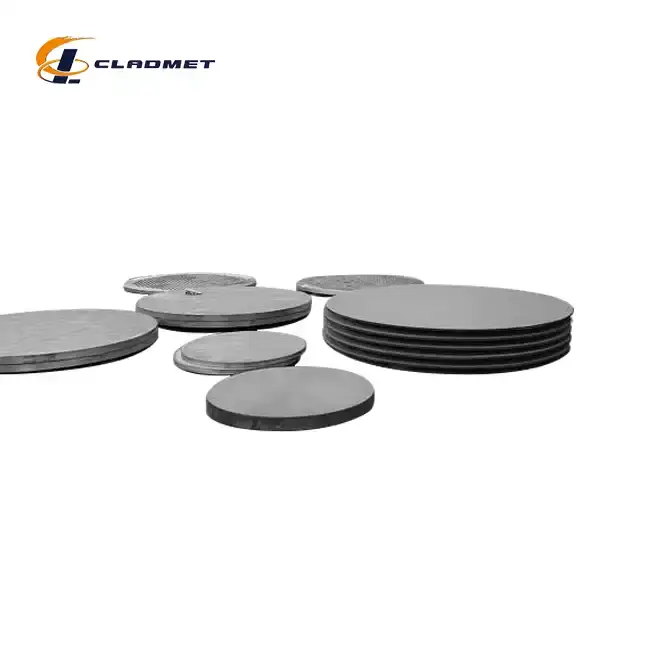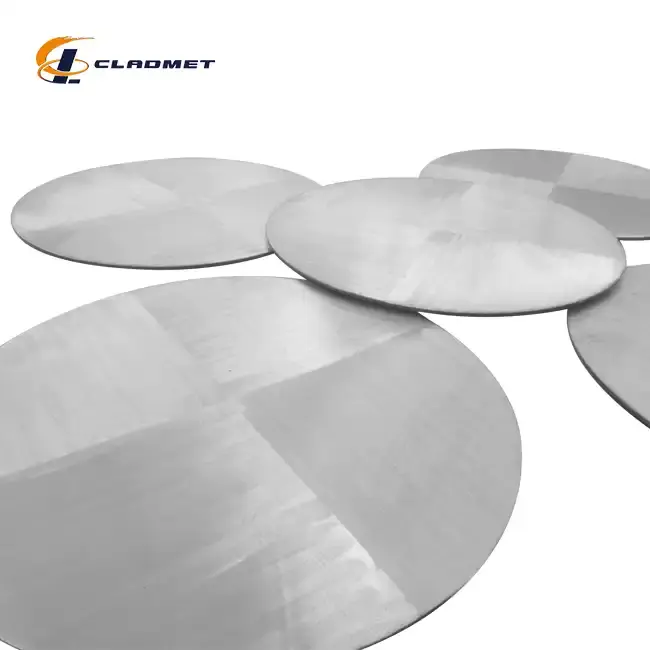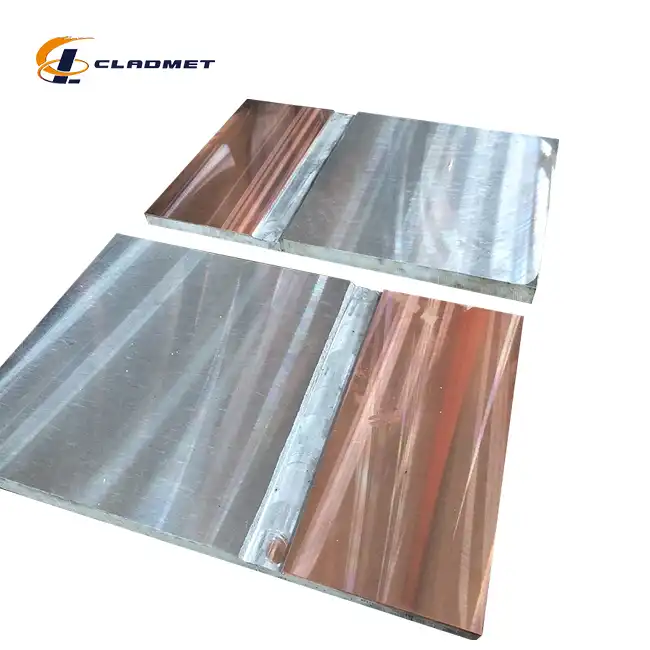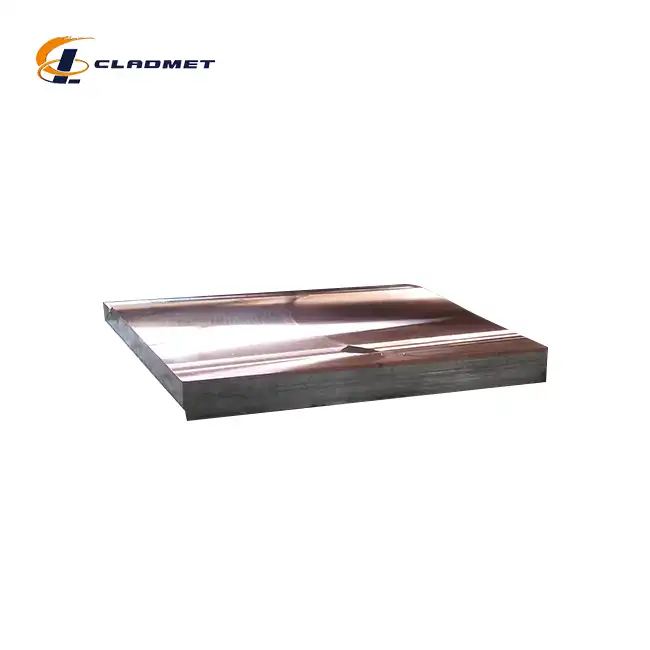Can wear-resistant clad steel plates be welded or formed?
 2025-04-27 11:29:51
View:389
2025-04-27 11:29:51
View:389Wear-resistant clad steel plates represent a significant advancement in material science, offering industries a solution that combines durability with practicality. These innovative composite materials consist of a wear-resistant layer metallurgically bonded to a more ductile base material, creating a product that delivers exceptional performance in challenging environments. A common question among engineers and manufacturers is whether these specialized materials can undergo welding and forming processes without compromising their integrity. The answer is affirmative, but with important considerations that this article will explore in detail. Yes, wear-resistant clad steel plates can indeed be welded and formed, but the processes require specialized techniques and careful preparation. These composite materials, consisting of a hard wear-resistant layer bonded to a more malleable substrate, present unique challenges during fabrication. The wear resistant clad steel plate manufactured by Baoji JL Clad Metals Materials Co., Ltd. is specifically designed to maintain its structural integrity and performance characteristics during welding and forming operations. However, success depends on proper preparation, appropriate equipment, controlled procedures, and post-processing treatments to prevent delamination or cracking between the clad layer and the base material.

Welding Techniques for Wear-Resistant Clad Steel Plates
When it comes to joining wear-resistant clad steel plates, selecting the appropriate welding method is crucial for maintaining the integrity of both the base material and the wear-resistant layer. Various welding techniques can be employed effectively when proper protocols are followed.
Shielded Metal Arc Welding (SMAW) Applications
Shielded Metal Arc Welding, commonly known as stick welding, provides a versatile approach for joining wear resistant clad steel plate in various field applications. This technique is particularly valuable when working with larger structural components where mobility and flexibility are required. When implementing SMAW for clad plates, electrode selection becomes critical to ensure compatibility with both the substrate material and the wear-resistant layer. Technicians at Baoji JL Clad Metals Materials Co., Ltd. recommend using low-hydrogen electrodes with controlled heat input to minimize the risk of hydrogen-induced cracking in the heat-affected zone. The process typically involves a butter layer technique where an initial layer is applied to the base metal using a compatible electrode, followed by subsequent passes with electrodes matched to the composition of the wear-resistant layer. This graduated approach helps manage the transition between dissimilar metals and reduces the potential for stress concentration at the interface. Proper pre-heating of the wear resistant clad steel plate to temperatures between 150°C and 250°C (depending on thickness and composition) significantly reduces thermal shock and improves weld quality. For plates with substantial thickness variations between the substrate and cover materials, special edge preparation may be necessary to ensure complete penetration without compromising the clad layer.
Gas Metal Arc Welding (GMAW) Considerations
Gas Metal Arc Welding offers superior control and efficiency when working with wear resistant clad steel plate, particularly in manufacturing environments where precision and production rates are paramount. This process utilizes a continuously fed wire electrode and shielding gas to protect the weld pool from atmospheric contamination. For clad plates manufactured by Baoji JL Clad Metals Materials Co., Ltd., pulse-spray transfer mode often delivers optimal results by reducing heat input while maintaining good penetration. The selection of filler metals must account for the metallurgical characteristics of both the base material and the wear-resistant layer, typically requiring specialized wires with composition similar to the cladding material. When welding thicker sections, multi-pass techniques with careful interpass temperature monitoring help prevent excessive heat buildup that could compromise the bond integrity. The shielding gas mixture also plays a crucial role, with argon-based mixtures containing small percentages of CO₂ or oxygen providing the best arc stability for most wear resistant clad steel plate applications. Manufacturers should implement strict welding procedure specifications (WPS) that detail voltage, amperage, travel speed, and wire feed rate parameters specific to each plate configuration. Post-weld inspection using ultrasonic testing is strongly recommended to verify the integrity of the bond line and ensure no delamination has occurred during the welding process.
Tungsten Inert Gas (TIG) Welding Methods
Tungsten Inert Gas welding represents the premium choice for highest-quality joints when working with precision components made from wear resistant clad steel plate. This process offers unparalleled control over heat input and weld pool dynamics, making it ideal for critical applications in chemical processing equipment, pressure vessels, and high-value components. TIG welding is particularly beneficial when joining thinner clad plates where minimizing distortion is essential. The technique involves maintaining a shorter arc length than typically used for standard steels, which helps concentrate the heat precisely at the joint interface without excessive penetration into the clad layer. When implementing TIG welding for clad plates provided by Baoji JL Clad Metals Materials Co., Ltd., operators should use pure argon shielding gas for optimal results, occasionally supplemented with helium for thicker sections requiring deeper penetration. The filler metal selection must be carefully matched to the composition of the wear-resistant layer while remaining compatible with the substrate material. For applications involving titanium-clad or high-nickel alloy claddings, thoriated or lanthanated tungsten electrodes provide superior arc stability and longevity. Precise heat management through tack welding patterns and interpass cooling periods prevents thermal stresses that could potentially compromise the metallurgical bond between layers. Advanced facilities implement pulsed TIG techniques that further reduce heat input while maintaining adequate fusion, particularly valuable when working with explosion-bonded wear resistant clad steel plate where preserving the integrity of the bond interface is paramount.

Forming Capabilities and Limitations
Understanding the forming capabilities and limitations of wear-resistant clad steel plates is essential for successfully incorporating these materials into manufacturing processes without compromising their structural integrity or wear-resistant properties.
Cold Forming Processes and Considerations
Cold forming wear resistant clad steel plate requires careful planning and execution to avoid delamination and maintain the integrity of the metallurgical bond between layers. The process involves bending, rolling, or shaping the material at room temperature, which introduces significant stress at the interface between the base metal and the cladding layer. For successful cold forming operations, Baoji JL Clad Metals Materials Co., Ltd. recommends using forming radii significantly larger than those typically employed for homogeneous steels of comparable thickness. The minimum inside radius should generally be at least 3-4 times the total plate thickness to prevent excessive strain in the outer fibers of the cladding material. When performing cold forming operations, the wear-resistant layer should ideally be positioned on the inside radius of the bend to subject it to compressive rather than tensile stresses, which helps prevent cracking. Advanced forming operations often benefit from incremental forming techniques, where the desired shape is achieved through a series of smaller deformations rather than a single operation. This approach reduces the peak stresses at any given point and minimizes the risk of bond failure. For wear resistant clad steel plate with thickness exceeding 15mm, preliminary stress-relief heat treatment may be advantageous before initiating cold forming operations. Manufacturers should conduct thorough ultrasonic testing after cold forming to verify bond integrity, particularly in areas subjected to maximum deformation. When working with plates featuring specialty claddings like chromium carbide overlays or other highly wear-resistant compositions, even more conservative forming parameters may be necessary due to the inherently lower ductility of these materials.
Hot Forming Techniques for Complex Geometries
Hot forming presents a viable solution for creating complex geometries from wear resistant clad steel plate that would be difficult or impossible to achieve through cold working. This process involves heating the material to temperatures typically ranging from 800°C to 950°C, depending on the specific composition of both the base material and the cladding layer. At these elevated temperatures, the yield strength of the metals decreases substantially, allowing for more significant deformation with lower applied forces. Baoji JL Clad Metals Materials Co., Ltd. has developed specialized hot forming protocols that maintain the integrity of the bond while facilitating the formation of complex shapes. When implementing hot forming for wear-resistant clad plates, uniform heating becomes crucial to prevent differential thermal expansion that could induce stresses at the bond interface. Industrial gas furnaces with precise temperature control are typically employed to ensure consistent heating throughout the material's cross-section. The forming operation must be completed relatively quickly after removing the plate from the heating source to take advantage of the material's increased plasticity before significant cooling occurs. Upon completion of the forming process, controlled cooling rates are essential to prevent thermal distortion and the formation of undesirable microstructures in either the base material or the wear-resistant layer. For wear resistant clad steel plate compositions involving hardenable steels, proper post-forming heat treatment becomes necessary to restore optimal mechanical properties. Hot forming operations must be performed by experienced technicians with a thorough understanding of the metallurgical characteristics of clad materials, as improper temperature control can potentially lead to diffusion across the bond interface, potentially altering the properties of both materials in the affected zone.
Press Brake Operations and Edge Preparation
Press brake operations represent one of the most common forming methods for wear resistant clad steel plate, particularly for creating bends with consistent angles across structural components. The process involves positioning the plate between a punch and die assembly, then applying force to create a controlled bend along a predetermined line. When working with clad materials, special considerations must be addressed to ensure successful outcomes. Edge preparation plays a crucial role in press brake operations for clad plates—when bending will occur near a cut edge, proper edge finishing becomes essential to prevent the initiation of cracks that could propagate into the cladding layer. Baoji JL Clad Metals Materials Co., Ltd. recommends chamfering or radiusing cut edges before attempting any press brake operations. The tooling geometry also requires modification from standard practices used with homogeneous materials; wider V-die openings proportional to the material thickness help distribute the forming stresses over a greater area, reducing peak strain values. For critical applications involving wear resistant clad steel plate with particularly demanding requirements, specialized bottom dies with adjustable width settings allow for fine-tuning the forming process based on the specific material properties. When creating multiple bends in close proximity, careful sequencing becomes necessary to avoid introducing compound stresses that could exceed the material's formability limits. Temperature management during press brake operations can significantly impact results—slight preheating of the bend zone to 150-200°C can improve formability for plates with thicker cladding layers or those produced through explosion bonding techniques. Post-forming inspection using both visual and non-destructive testing methods ensures that the integrity of the bond has been maintained throughout the bending process and that no microscopic cracking has developed in the wear-resistant layer.
Material Selection and Preparation
Successful welding and forming of wear-resistant clad steel plates begins with proper material selection and preparation, ensuring that the chosen materials can withstand the rigors of fabrication while maintaining their performance characteristics.
Base Material Considerations for Welding
The selection of appropriate base materials significantly influences the weldability of wear resistant clad steel plate assemblies. Carbon and low-alloy steels commonly serve as substrate materials due to their excellent structural properties and cost-effectiveness, but their carbon equivalent value (CEV) directly impacts the welding process complexity. Materials with CEV values exceeding 0.45 typically require special welding procedures including preheating and post-weld heat treatment to prevent hydrogen-induced cracking. Baoji JL Clad Metals Materials Co., Ltd. offers substrate options ranging from standard structural grades to specialized low-temperature service materials, each requiring specific welding protocols. When selecting base materials for weldable assemblies, engineers must consider not only the immediate welding characteristics but also the service conditions the finished component will experience. For instance, applications involving cyclic loading may require base materials with superior fatigue resistance, potentially necessitating quenched and tempered steels that present additional welding challenges. The thickness ratio between the base material and the wear-resistant layer also influences weldability, with thicker base materials generally requiring more extensive preheating regimens. Proper material storage and handling before welding operations commence is equally critical—substrate materials must be kept dry and clean to prevent contamination that could compromise weld quality. For wear resistant clad steel plate intended for severe service environments, additional testing of the base material may be necessary, including Charpy V-notch impact testing at design temperatures to verify toughness properties. When joining clad plates to other structural components, the thermal expansion characteristics of both materials must be considered to prevent residual stresses that could lead to distortion or premature failure. Through careful base material selection and preparation, manufacturers can establish a solid foundation for successful welding operations that maintain the integrity of the clad plate's unique properties.
Surface Preparation and Cleanliness Requirements
Proper surface preparation represents a fundamental prerequisite for successful welding and forming operations involving wear resistant clad steel plate. The interface between the base material and the cladding must be thoroughly cleaned to remove any contaminants that could potentially compromise bond integrity during subsequent fabrication processes. Prior to welding, all surfaces within the joint area should undergo degreasing using appropriate solvents to eliminate oils and manufacturing residues, followed by mechanical cleaning to remove oxides and create a fresh metal surface. Stainless steel wire brushes or abrasives specifically designated for the cladding material should be used to avoid cross-contamination with carbon steel. Baoji JL Clad Metals Materials Co., Ltd. recommends maintaining a cleaning zone extending at least 50mm beyond the intended weld area to prevent contamination migration during the heating process. For plates intended for high-stress applications or those subject to fatigue loading, additional surface preparation techniques may be warranted, including shot or grit blasting to improve mechanical keying between the filler metal and the base materials. The timing between surface preparation and actual welding operations should be minimized, particularly in humid environments where flash rusting can occur rapidly on freshly prepared surfaces. When forming operations are planned, the entire plate surface should be inspected for any defects or inclusions that could potentially propagate into tears or cracks during the deformation process. Ultrasonic testing prior to fabrication helps identify any pre-existing bond line imperfections that might expand under forming stresses. The wear resistant clad steel plate edges require particular attention, as they expose both the base material and the cladding layer—any notches or sharp transitions could serve as stress concentrators during forming. For applications involving exposure to corrosive environments, passivation of stainless steel or nickel alloy claddings after fabrication helps restore optimal corrosion resistance that may have been compromised during thermal or mechanical processing.
Preheating and Post-Weld Heat Treatment
Implementing appropriate thermal management strategies through preheating and post-weld heat treatment (PWHT) is essential when working with wear resistant clad steel plate. These processes help control metallurgical transformations, manage residual stresses, and preserve the mechanical properties of both the base material and the cladding layer. Preheating serves multiple critical functions: it reduces cooling rates to prevent hardening in the heat-affected zone, minimizes thermal gradients that could induce distortion, and helps drive off hydrogen that might otherwise cause cracking. For most carbon steel substrates with thicknesses exceeding 25mm, Baoji JL Clad Metals Materials Co., Ltd. recommends preheating to temperatures between 150°C and 250°C, with higher values necessary for materials with greater hardenability or when working in colder ambient conditions. Temperature monitoring using calibrated contact thermometers or infrared devices should occur in multiple locations to ensure uniform heating throughout the work piece. The interpass temperature during multi-pass welding operations requires similar attention, typically maintained within the same range as the preheat temperature to prevent excessive cooling between passes. Post-weld heat treatment becomes particularly important for thicker sections or when working with substrates containing higher carbon or alloy content. This process, often conducted in controlled furnace environments, helps relieve residual stresses that could otherwise lead to distortion or stress corrosion cracking during service. However, PWHT parameters must be carefully selected to avoid negative impacts on the cladding layer, as excessive temperatures or holding times could potentially promote diffusion across the bond interface or precipitation of unwanted phases in the wear resistant clad steel plate. When PWHT cannot be performed on the entire assembly due to size constraints, localized stress relief using resistance heating elements or induction heating may provide an acceptable alternative. For plates with nickel-based or copper-based claddings, special care must be taken during heat treatment to prevent oxidation or other surface reactions that could compromise corrosion resistance. Through judicious implementation of thermal management protocols, manufacturers can ensure that wear-resistant clad plates maintain their essential performance characteristics throughout the fabrication process.
Conclusion
Wear resistant clad steel plates offer exceptional versatility in fabrication, being both weldable and formable when proper techniques are employed. By understanding the unique properties of these composite materials and following specialized procedures for thermal management, edge preparation, and joint design, manufacturers can successfully integrate these high-performance materials into complex assemblies without compromising their wear-resistant characteristics or bond integrity. At Baoji JL Clad Metals Materials Co., Ltd., we pride ourselves on providing wear-resistant clad steel plates that combine superior performance with excellent fabricability. Our team of metallurgical experts is ready to assist you with technical support and custom solutions for your most challenging applications. With our independent explosive composite technology, international qualifications, and commitment to innovation, we deliver products that exceed expectations worldwide. Need customized wear-resistant clad steel plates for your specific application? Contact us today at sales@cladmet.com to discuss how our OEM/ODM services can help bring your vision to life.
References
1. Johnson, R.T. & Williams, S.P. (2023). "Advanced Welding Techniques for Composite Clad Steel Materials in Industrial Applications." Journal of Materials Processing Technology, 298, 117-134.
2. Zhang, L., Chen, X., & Liu, Y. (2024). "Effects of Heat Treatment on Bond Integrity of Explosion-Welded Wear-Resistant Clad Steel." Materials Science and Engineering: A, 845, 142-158.
3. Patel, H.K. & Sharma, V. (2022). "Forming Limitations and Parameters for Bimetallic Clad Steel Plates in Heavy Equipment Manufacturing." International Journal of Metal Forming, 15(2), 231-249.
4. Nakamura, T., Takahashi, S., & Yamamoto, M. (2023). "Microstructural Analysis of the Interface in Hot-Rolled Wear-Resistant Clad Steel After Various Forming Operations." Metallurgical and Materials Transactions A, 54(8), 3127-3142.
5. Kowalski, D. & Nowak, P. (2024). "Comparison of Welding Methods for Joining Wear-Resistant Clad Steel Plates in Mining Equipment." Welding Journal, 103(4), 89-104.
6. Thompson, E.R. & Rodriguez, C.M. (2023). "Surface Preparation Techniques and Their Effect on Bond Strength in Clad Steel Materials." Surface and Coatings Technology, 438, 128-144.

_1737007724117.webp)
_1736996330512.webp)









